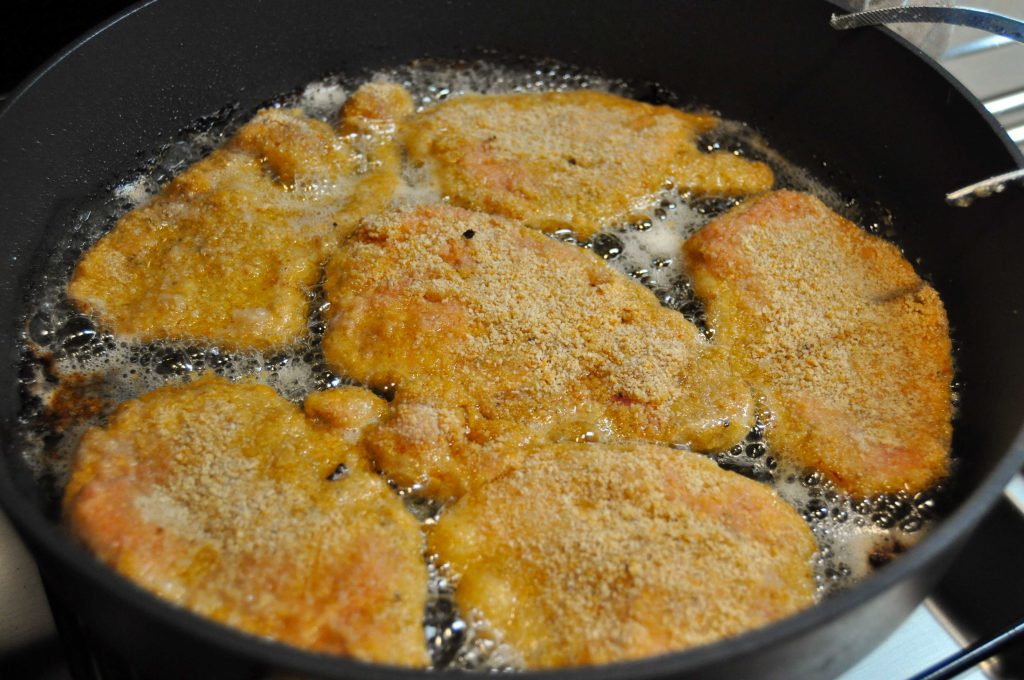There are countless variations of the schnitzel: In general, the schnitzel refers to a thin fried slice of meat made from veal, pork or poultry. In addition, the Schnitzel is served with a breading, which consists mainly of breadcrumbs and is enriched with other ingredients, depending on the recipe.
The “breading” has a long tradition: in the Middle Ages it was common to bread schnitzel with gold leaf. Schnitzels breaded with gold leaf can be traced back to the ninth century. In 1514, it became obvious that the use of gold leaf as breading had become excessive: the gilding of food was banned. Consequently, alternatives were sought: The choice fell on a breading made of breadcrumbs, which resembled gold leaf in its golden yellow color. In addition, the use of breadcrumbs made it possible to use leftover bread in an appealing way.
The Wiener Schnitzel
One of the most famous variations of the Schnitzel is the Wiener Schnitzel: the meat for an original Wiener Schnitzel is classically cut from the topside of a calf. In Austria, the topside of the calf is called the “emperor’s cut”.
To get as much as possible out of the veal, the pieces of meat are cut in a butterfly cut.
In addition to the topside, flank or rump also provide good meat for schnitzel. The preparation of a Wiener Schnitzel is divided into three main steps: Seasoning, breading and frying.
Seasoning and breading
First, dry the raw veal cutlets. Now pound the veal until they are thin. Next, season the cutlets on both sides with salt and pepper.
Then bread the schnitzels: first flour the schnitzels. Now pull the schnitzels through beaten eggs: The eggs act as “glue” for the breading.
In the last step of breading, both sides of the schnitzels are covered with breadcrumbs.

Frying
After the breading comes the frying: For this, heat neutral oil and butter in a pan. In this pan, fry the schnitzels for two to three minutes on each side until the breading is golden brown. Typically, the schnitzels are served with lemon slices, chives and parsley.
While the Wiener Schnitzel is the most classic method of preparation, it is only one of many Schnitzel variations: The Piccata alla Milanese schnitzel variation uses Parmesan cheese for the breading. Piccata alla Milanese is often referred to as Milanese Schnitzel: Milanese Schnitzel is often served with spaghetti with tomato sauce.
Origins of the Wiener Schnitzel
It is often debated where the Schnitzel originally came from: the original home of the Wiener Schnitzel is said to be in the area around Milan. Numerous sources claim that the dish Piccata alla Milanese (Milanese Schnitzel) is the original form of Wiener Schnitzel.
From Milan it is said to have reached the royal-imperial court in Vienna in the 19th century. According to legend, the Austrian field marshal Radetzky, after whom Johann Strauss’ Radetzky March is named, played a major role in this.
Legend or not: It took a while before breaded schnitzel was called “Wiener Schnitzel”.
The term “Wiener Schnitzel” first appeared in a Bohemian cookbook from 1884: It is safe to assume that the term “Wiener Schnitzel” did not become established until the 20th century.
Italian origin?
There are numerous legends surrounding the origins of the Wiener Schnitzel: To this day, it is not exactly clear where the Wiener Schnitzel originally came from. The theory that the Wiener Schnitzel comes from Italy is countered by the fact that it was already common practice in Vienna to fry pieces of meat before 1848. Hardly any other cuisine works with so much baked meat as the Viennese cuisine.
A Wiener Schnitzel does not necessarily have to be made of veal: If breaded chicken is served, it is called Wiener Backhendl. For breaded pork, the name “Schnitzel Wiener Art“ [Schnitzel Viennese Style] has become established and can be found on numerous menus.
Vienna: The capital of schnitzel
Hardly any Austrian dish is as well known as the Wiener Schnitzel: people from all over the world are familiar with the Wiener Schnitzel. In addition to numerous cultural attractions, the city of Vienna offers its visitors one thing above all: the opportunity to eat a genuine Wiener Schnitzel. In Austria, the preparation and eating of the schnitzel enjoys a high status: many restaurants adhere to strict rules when preparing the schnitzel.
There are even dedicated culinary guidebooks that pave the way for Schnitzel lovers through the Schnitzel El Dorado of the city of Vienna.
Cover picture: A plate full of Schnitzel Viennese style, © Simon von Ludwig
Main sources: The German Teubner edition “The great book of meat” and various cookbooks.

 Deutsch
Deutsch